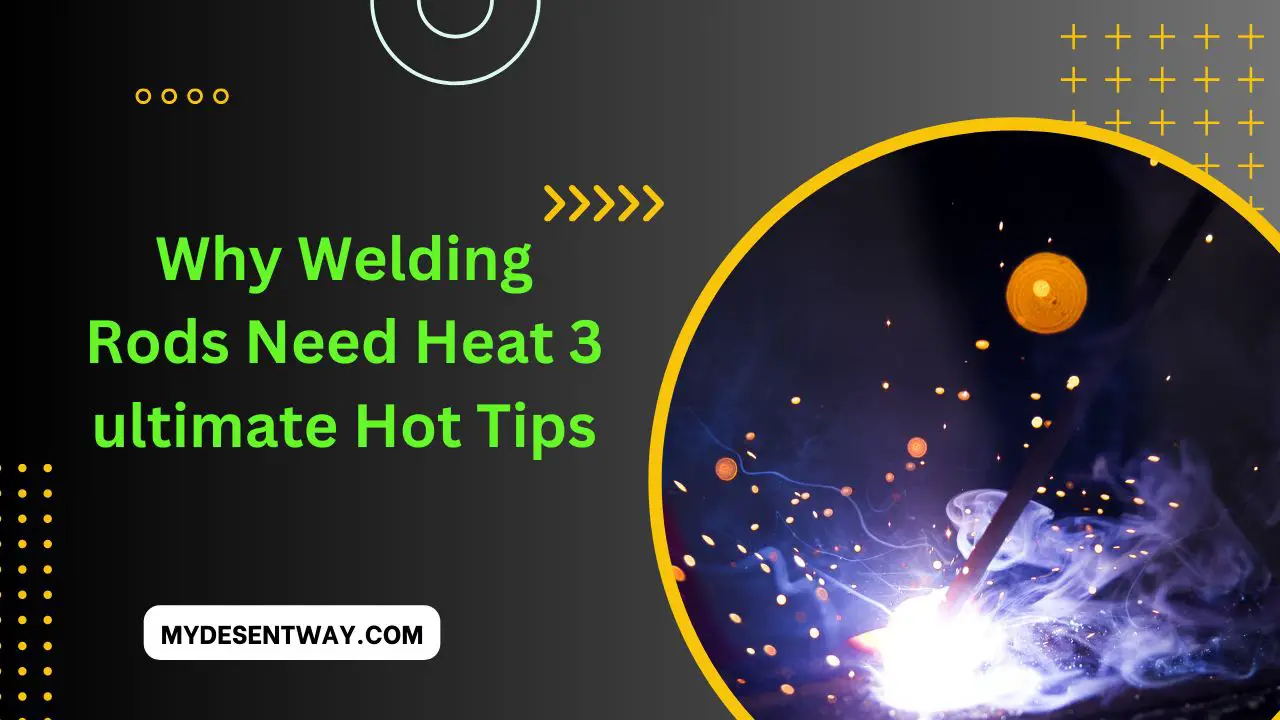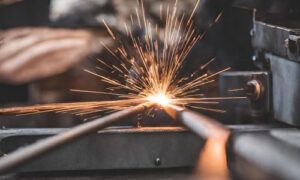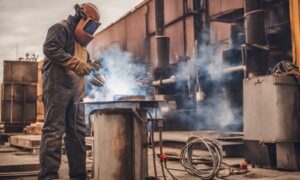Table of Contents
Welding rods form the backbone of the welding process. Their interaction with heat is the key to successful welds. Understanding this crucial relationship unlocks the secrets to durable and reliable welding joints. Let’s delve into the pivotal role heat plays in welding rods.
2. The Role of Heat in Welding
Understanding Welding Rods
Welding rods, also known as welding electrodes, are conductors of electric current in welding processes. These rods come in various compositions and sizes, each tailored for specific welding applications. When an electric current passes through the rod, it generates intense heat at the tip, initiating a chemical reaction within the rod itself.
Heat’s Influence on Welding Rods
Heat is the catalyst that transforms the welding rod from a solid state to a molten form. As the temperature rises, the rod melts, and the molten material fuses with the joined metals. This fusion creates a robust bond between the metals, forming the weld joint.
The level of heat applied determines the penetration depth into the base metals and the weld quality. The optimal temperature allows for efficient fusion without causing excessive distortion or weakening of the materials.
Understanding the intricate interplay between heat and welding rods is fundamental to mastering the art of welding. It’s not just about applying heat but knowing how different heat levels impact the materials being joined, ensuring a solid and durable bond.
3. Types of Welding Rods
Classification Based on Material
Welding rods vary significantly based on the materials they are made of, catering to different welding requirements. Here are some common types:
- Mild Steel Rods: These rods are ideal for general-purpose carbon and low alloy steel welding. They offer versatility in various welding positions and are widely used in construction and fabrication.
- Stainless Steel Rods: Explicitly designed for welding stainless steel, these rods ensure corrosion-resistant and robust welds. They come in different grades suitable for specific stainless steel compositions.
- Aluminum Rods: Used for welding aluminum and aluminum alloys, these rods are highly specialized due to aluminum’s unique properties. They provide excellent strength and corrosion resistance when welding aluminum structures.
- Flux-covered Rods: These rods contain a flux coating, providing a protective gas shield during welding. They’re versatile and suitable for various metals, including mild steel, stainless steel, and cast iron.
Different Rods for Different Heats
Each type of welding rod is designed to withstand and perform optimally at specific temperatures. For instance:
- Mild steel rods work well at lower temperatures and are suitable for joining steel structures without causing excessive heat distortion.
- Stainless steel rods require higher temperatures to ensure proper fusion and maintain the stainless properties of the welded joint.
- Aluminum rods demand precise heat control due to aluminum’s sensitivity to high temperatures, ensuring a clean weld without compromising the metal’s integrity.
Understanding the specific requirements of different metals and welding conditions is essential in selecting the right welding rod. Using the appropriate rod for the given heat conditions ensures efficient fusion and the creation of durable welds tailored to the material being joined.
4. Heat and Chemical Composition of Welding Rods
Impact of Heat on Rod Composition
When heat is applied to a welding rod, it initiates chemical changes within its composition. The intense heat causes the rod to melt, exposing its core components to the welding environment. As the rod melts, its chemical elements react with the welded base metals.
For instance, in the case of mild steel rods, the heat triggers the melting of the rod, allowing the iron in the rod to combine with the base steel, forming a metallurgical bond. This fusion creates a solid joint that is stronger than the individual metals.
Choosing Rods for Specific Temperatures
Different welding projects require specific temperatures for optimal results. Understanding the impact of heat on rod composition is crucial in selecting the appropriate welding rod for a given temperature range. For example:
- For lower heat applications, where precise control is needed, selecting a rod with a composition that melts at a lower temperature is essential. This ensures that the rod doesn’t liquify too quickly or cause overheating.
- Choosing rods with elements that can withstand elevated temperatures without compromising their structural integrity becomes paramount in higher heat situations. This ensures the rod maintains its strength and performance throughout the welding process.
Matching the welding rod’s composition with the required temperature range ensures efficient fusion, preventing issues like weak joints or incomplete bonding. Considering the chemical composition’s behavior under heat is vital to achieve optimal results in welding different materials and conditions.
5. The Importance of Heat Control
Heat Management Techniques
Precise heat control is paramount in welding to ensure the integrity and quality of the weld joint. Several techniques aid in effectively managing heat during the welding process:
- Preheating: This technique involves heating the base metals before initiating the welding process. Preheating reduces the risk of cracking in high-stress areas and aids in controlling the cooling rate post-welding, minimizing distortion.
- Heat Input Control: Regulating the heat input during welding prevents overheating, which can lead to material degradation. Adjusting current, voltage, and welding speed helps maintain optimal heat levels for the specific welding task.
- Post-Heating: After completing the weld, applying controlled heat to the welded joint can relieve residual stresses, enhancing the overall durability of the weld.
Achieving Optimal Welding Temperatures
Maintaining the proper temperature range is critical for successful welding. Factors such as the type of metal, welding technique, and rod composition influence the ideal temperature. Striking a balance between heat input and the properties of the materials being welded is critical to achieving optimal temperatures.
Adequate heat control not only ensures proper fusion but also minimizes the occurrence of defects like porosity, cracks, or weakened joints. The fine-tuning of heat management techniques leads to high-quality welds and durable structures.
6. Heat and Welding Techniques
How Heat Affects Welding Techniques
The application of heat significantly influences various welding techniques, impacting the overall welding process:
- Arc Welding: In this technique, heat is generated by creating an electric arc between the welding rod and the base metal. The heat from the arc melts the rod and the metals, forming a molten pool that solidifies to create the weld joint. Proper heat control ensures consistent and robust welds.
- MIG (Metal Inert Gas) Welding: Heat in MIG welding is generated by a continuous wire feeding into the welding arc. The heat melts the wire, which acts as the filler material, joining the metals together. Controlling the heat input is crucial to prevent excessive splatter or incomplete fusion.
- TIG (Tungsten Inert Gas) Welding: TIG welding uses a non-consumable tungsten electrode to create the arc. Heat is controlled precisely to melt the base metals and the filler rod, resulting in clean and precise welds. Managing heat is crucial in TIG welding to prevent overheating and maintain weld quality.
Matching Rods with Welding Styles
Different welding techniques demand specific types of welding rods for optimal performance:
- Arc welding often uses consumable welding rods designed for the specific heat generated by the electric arc.
- MIG and TIG welding rely on filler wires or rods suited to the welding style and the heat input required.
Matching the welding rod with the welding technique ensures compatibility and efficiency during the welding process. The interaction between heat and welding techniques is critical in achieving high-quality welds across various welding methods.
7. Heat and Welding Safety Measures
Safety Concerns Related to Heat
Working with heat during welding poses several safety hazards that need to be addressed to ensure a secure working environment:
- Burns: High temperatures in welding operations can cause severe burns if proper protective gear isn’t worn.
- Fires: Sparks and molten metal droplets can ignite flammable materials nearby, leading to fires.
- Fumes and Gases: Welding generates fumes and gases that, if inhaled, can harm health. These emissions may contain toxic substances and require proper ventilation.
- Eye and Skin Protection: Intense light and UV radiation produced during welding can damage eyes and skin. Welders must use appropriate protective gear, such as helmets with darkened lenses and flame-resistant clothing.
Tips for Welding Safely with Heat
To mitigate the risks associated with heat during welding, certain safety practices should be followed:
- Personal Protective Equipment (PPE): Wear appropriate PPE, including welding helmets, gloves, aprons, and boots, to safeguard against burns, sparks, and radiation exposure.
- Ventilation: Ensure adequate ventilation in the workspace to remove welding fumes and maintain air quality.
- Fire Safety: Keep fire extinguishers nearby and clear the work area of flammable materials to prevent accidental fires.
- Training and Awareness: Properly train welders on safe welding practices and make them aware of potential hazards associated with heat during welding operations.
Implementing these safety measures is crucial in minimizing the risks associated with heat exposure during welding, ensuring a secure working environment for welders and bystanders alike.
Conclusion
In conclusion, the symbiotic relationship between welding rods and heat is the cornerstone of successful welding. The reliance of welding rods on heat for fusion underscores their significance in the welding process. These rods, acting as conduits for electric current, harness heat to meld metals together, forging durable weld joints.
Understanding this interplay between welding rods and heat is foundational and pivotal in achieving sturdy, reliable welds across diverse materials and applications. Mastering the art of welding hinges upon comprehending and effectively leveraging this essential relationship between welding rods and heat.
FAQs: Why Welding Rods Need Heat
Why is heat crucial in welding with rods?
Heat facilitates the melting of the welding rod and metal, enabling them to fuse and form a strong joint.
How does heat affect the choice of welding rods?
Different metals and welding conditions require specific temperatures, influencing the selection of suitable welding rods.
Do 7018 rods have to be heated?
Yes, 7018 rods are typically heated before use to ensure proper fusion, prevent porosity, and maintain the integrity of the weld joint.
What safety measures should one take when welding with heat?
Using protective gear, ensuring proper ventilation, and adhering to safety protocols are crucial when working with heat in welding.
Can improper heat control lead to welding defects?
Yes, inadequate heat control can result in welding defects like porosity, cracks, and weakened joints.




3 thoughts on “Why Heat Is Crucial for Welding Rods”